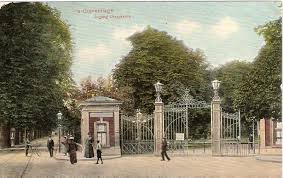The Hague has everything that you can wish for, apart from a Zoo. That was not the case in the years 1863-1943. The inhabitants of The Hague could enjoy themselves in the Royal Zoological Botanical Garden, which was situated on the spot where you now see the Provinciehuis.
The start
 It was Dr. L.H. Verwey, a doctor of medicine, who took the initiative for a zoological garden. In 1860 he presented a plan to the local government and to potential investors. His main “selling point” was that a zoo would be in line with all the other activities then advertised to attract foreign visitors and persons of wealthy independent means to the city.
It was Dr. L.H. Verwey, a doctor of medicine, who took the initiative for a zoological garden. In 1860 he presented a plan to the local government and to potential investors. His main “selling point” was that a zoo would be in line with all the other activities then advertised to attract foreign visitors and persons of wealthy independent means to the city.
Social revolution
The financial arrangements of the garden gave rise to a social revolution. In the later 19th century society in The Netherlands and in The Hague was much more class-divided than it is today. Existing social clubs welcomed only members of the aristocracy, high ranked civil servants and very wealthy citizens. In contrast, the Zoo offered a shareholder-membership for 50 guilders, with no ballot. This meant that membership in this new social club came within reach of other inhabitants, such as lower ranked civil servants, professionals (doctors, lawyers), entrepreneurs in trade and industry, and craftsmen and shopkeepers. Even women had the opportunity to become members – a highly revolutionary idea at the time. Widows could take over the membership of their deceased husbands. But also independent women could apply. And all these women had voting rights!
The garden provided a neutral territory where residents of the Hague from many walks of life could meet.
What there was to enjoy
 Visitors could stroll along paths and ponds, watch birds and view tropical plants and a motley collections of animals. Besides a feast for the eyes, there was also a feast for the ears. In the summertime the military band gave concerts twice a week. Often thousands of The Hague families came and listened.
Visitors could stroll along paths and ponds, watch birds and view tropical plants and a motley collections of animals. Besides a feast for the eyes, there was also a feast for the ears. In the summertime the military band gave concerts twice a week. Often thousands of The Hague families came and listened.
Construction of the park and the large society building had taken a lot of money. So there was not much left to buy animals. Therefore the zoo depended very heavily on donations in kind. Because mostly birds were donated, the zoo was nicknamed the ‘chicken garden’. At some point the board decided to invest mainly in birds and plants, rather than in expensive mammals.
What became of the zoo?
 As with so many beautiful parts of The Hague, the zoological garden became a casualty of the Second World War. The so-called Atlantikwall ran right through the garden. The zoo was evacuated and the large animals went to Artis (Amsterdam) and Blijdorp (Rotterdam). Smaller animals and many plants found new homes in The Hague’s Zuiderpark. The Moorish-style main building remained still in use and it was the only part of the garden that was restored after the war. Many a resident of The Hague sat there to pass an exam or to watch a (children’s) performance. Despite much protest, in 1968 the building had to make way for the extension of the Provinciehuis.
As with so many beautiful parts of The Hague, the zoological garden became a casualty of the Second World War. The so-called Atlantikwall ran right through the garden. The zoo was evacuated and the large animals went to Artis (Amsterdam) and Blijdorp (Rotterdam). Smaller animals and many plants found new homes in The Hague’s Zuiderpark. The Moorish-style main building remained still in use and it was the only part of the garden that was restored after the war. Many a resident of The Hague sat there to pass an exam or to watch a (children’s) performance. Despite much protest, in 1968 the building had to make way for the extension of the Provinciehuis.
Film: 1939 a school class visits the Zoological Garden
I will tell you more about the history and architecture of The Hague during my city walks and bicycle tours



1 thought on “The Hague Zoo”
PARFAIT et Merci, je suis ravis de savoir que l’on garde la mémoire de nos vieux zoos.
Pour ma part, j’écris un roman évoquant différentes anecdotes de zoos. Si avez d’autres histoires à me transmettre, je ne manquerai pas d’en écrire une dans mon livre.
MERCI d’avance pour votre réponse.
Bien à vous.
Jean-Louis d’Orny.